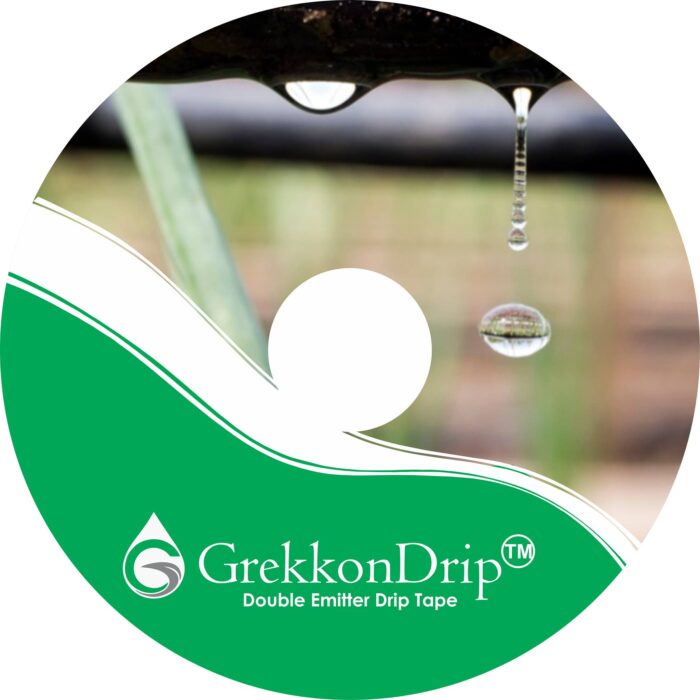
Drip Irrigation System
Every drip irrigation system in Kenya by Grekkon Limited supported by a HDPE or PVC line. We are the largest drip irrigation kits suppliers in Kenya, reaching the highest number of farmers. At the very bottom we do simple drip irrigation systems, also known as kitchen garden drips
It advances to 1 acre drip irrigation kits, 5 acre drip irrigation systems to hundreds of acres. Our drip pipes for sale in Kenya are the double emitter drip irrigation pipes
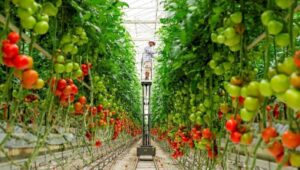
Drip Irrigation Kits Prices In Kenya Are A Factor Of
- Crop type
- Bed spacing
- Terrain
Drip Irrigation System Cost Per Acre In Kenya
| Crop Type | Lines Per Bed | Acreage | Cost in Kes |
| Watermelon, sweet melon, butter nut | 1 | 0.125 | 15,000 |
| 0.25 | 25,000 | ||
| 0.50 | 45,000 | ||
| 1 | 85,000 | ||
| Tomato, cabbage, chillies, capsicum | 2 | 0 | 25,000 |
| 0.25 | 40,000 | ||
| 0.50 | 75,000 | ||
| 1 | 140,000 | ||
| Onion, garlic, herbs, spices, strawberry, green beans | 0 | 27,500 | |
| 3 | 0.25 | 45,000 | |
| 0.50 | 85,000 | ||
| 1 | 160,000 |
Drip Kit Components
- The main line. This is a PVC or a HDPE pipe. The choice of pipe thickness is according to the pressure of the water in it. A farmer with gravity flow has a thinner pipe than one with a high pressure water pump
- Water filter. To remove impurities that will otherwise block the drip pipe emitters
- Gate vales. They control the water movement from one point to another by opening or closing
- Main line fittings; tees, elbows, adaptors, connectors, saddle clamps, reducers, and end caps. They are either PVC or HDPE as per the pipe. Their size depends on the pipe size
- The sub main line. This is connected to the main line, and is the origin of drip lines
- Sub-main line fittings; tees, elbows, adaptors, connectors, saddle clamps, reducers, and end caps. They are either PVC or HDPE as per the pipe. Their size depends on the pipe size
- Drip pipes. These pre-perforated pipes have emitters that supply water to the crop directly
- Drip fittings; starter connectors, off take connectors, drip to drip connectors, rubbers, mini-valves, and end caps
Drip Irrigation Lines and Pipes
In this drip irrigation lines and pipes piece, we will answer commonly asked questions in relation to drip irrigation
1.What is drip irrigation tape?
This is a flat thin walled LLDPE material tube with sequential emitters for irrigation
2. How long do you water with drip tape?
This depends on the crop water need at the time of irrigation. It ranges from 25 minutes to 1.5 hours. It is recommended to irrigate daily over a short duration with the same amount of water to keep the crop happy
3. Can you re-use drip tape?
Yeas you will over several growing seasons. The thicker the wall size, the longer the re-use period
4. What is the maximum length of a drip irrigation line?
1,000M
5. How much water does drip tape put out?
This depends on the emitter specifications. We supply 1.5L/ hour, 2L/hour, and 3L/hour emitters in our drip tapes
6. How much do drip lines cost?
Grekkon Limited’s double emitter drip irrigation lines and pipes for sale in Kenya tapes are categorised by thickness; 0.3mm, and 0.4mm. Both are 16mm in diameter, 1,000M long and with a choice of emitter spacing as 15cm, 20cm, and 30cm
Cost of drip irrigation tapes
| Thickness | 0.3mm | 0.4mm |
| Price | KES 7,500 | KES 8,500 |
The choice of drip line thickness depends on
- is it for out door or greenhouse installation? 0.3mm is fine in the greenhouse because it is no directly exposed to sunlight
- radiation level. where the sun’s radiation is high, 0.4mm is better
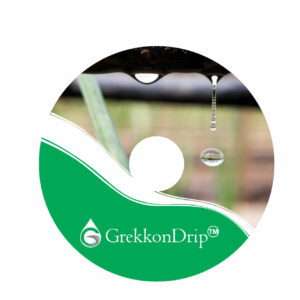
7. How much does it cost drip irrigation for 1 acre?
This depends on the crop type. Different crops have different drip irrigation piping requirements
Drip irrigation lines and pipes
By acreage pricing
| Crop Type | Lines Per Bed | Acreage | Cost in Kes |
| Watermelon, cucumber, butter nut | 1 | 0.125 | 15,000 |
| 0.25 | 25,000 | ||
| 0.50 | 45,000 | ||
| 1 | 85,000 | ||
| Tomato, cabbage, chilies, capsicum | 2 | 0.125 | 25,000 |
| 0.25 | 40,000 | ||
| 0.50 | 75,000 | ||
| 1 | 140,000 | ||
| Onion, garlic, herbs, spices, strawberry | 0.125 | 27,500 | |
| 3 | 0.25 | 45,000 | |
| 0.50 | 85,000 | ||
| 1 | 160,000 |
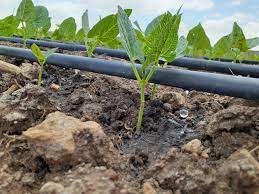
Drip irrigation on green beans by Grekkon Limited
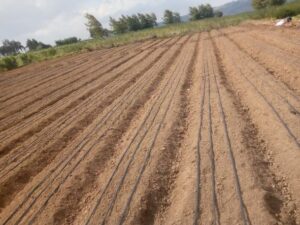
Drip irrigation pipes for onion installed by Grekkon Limited
8. What time of day is best for drip irrigation?
Early morning is highly recommended. If not, then in the evening
9.How much pressure does a drip irrigation system need?
The minimum operating pressure is 3M or 0.3 bar
10. What pipes size should I use for drip irrigation?
There are 3 lines in an irrigation set-up
- main line. This one delivers water to the farm from the source; tank, water pan, lake or river. It is the largest
- sub-main line. It is connected to the main line to supply water to the drip irrigation tubes. It is lesser in diameter than the main line
- drip irrigation tape. it supplies water directly to the crop
The pipe size is a factor of acreage. The main line diameter size on 10 acres is larger than the main line diameter size on half an acre of drip irrigation. These pipes are either HDPE or PVC types
11. How do I start my own drip?
Our technical team guides new drip irrigation farmers on starting out. These are the steps to follow
- identify the area to undertake drip irrigation. It will have a close water source
- what crop is to be grown? this will guide on the number of drip rows per bed
- what is your budget? it determines the acreage to set up the system
